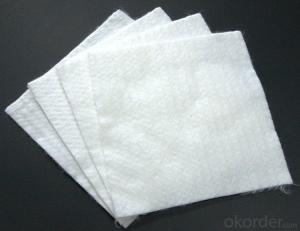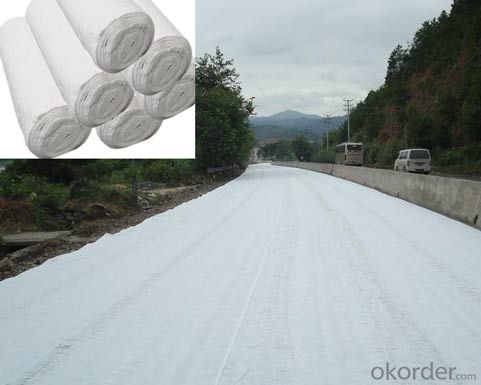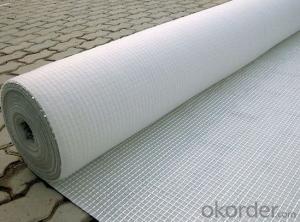Geotextile Fabric Construction PP/PET Nonwoven Geotextile with Short Fiber
- Loading Port:
- China main port
- Payment Terms:
- TT OR LC
- Min Order Qty:
- 10000 m²
- Supply Capability:
- 5000000 m²/month
OKorder Service Pledge
OKorder Financial Service
You Might Also Like
Non Woven Geotextile with Short Fiber Needle Punched, Find Details about Non Woven Geotextile with Short Fiber Needle Punched and Make an Inquiry for Geotextile at OKorder.com.
Geotextile Specifications:
Geotextile fabrics
Material:polyester/polypropylene fibric
Width:1-9m
Colour:white or black
Use:road ,highway,filter
Weight:100-1500g/m2
Tensile strength:2.5KN/m-25KN/m
Break elogation:25-100%
Gextextile Description:
--Our geotextile can be made of polypropylene (PP) or polyester (PET) .
-- The weight is available from 100g/m2 to 1500g/m2 and the width from 1m to 8m,
-- Two kinds of processing technical to select: needle punched and thermally bonded, long fiber or short fiber.
-- All kinds of colors are available.
It is widely known as earthwork material and industry fabric, used in the areas of railway, highway, water conservancy, dam, tunnel, subway, environment protection and so on.
-- We can supply different specifications as customers’ request.
Geotextile Specification:
Material: polypropylene (PP) thermally bounded
Weight: 100g/m2-1500g/m2
Width: 1-9m
Length: As customers’ demand (usually is 100m)
Package: PE film and woven cloth
Delivery time: With in 3weeks after received the advance payment
Payment terms: T/T 30% in advance+T/T 70% against the copies of original documents or L/C
PS. Also we can produce the product as customer’s demand.
Application of Geotextile:
1. Filtration
The filtration layer of the dykes, river canal, seacoast, concrete slope, retaining walls. At the same time of preventing the clay granule from passing, it allows the water and the gas pass through freely.
2. Separation
The isolation of the railway dregs and the roadbed, roadbed and the soft base, surface of the airdrome and parking lot and the groundsill, different dam materials. It isolates the soil and the gravel of two kinds different granule pathway from the groundsill or other buildings.
3. Reinforcement
The highway, railway, soilstone dam, breakwater, airport, backfill soil of retaining wall, slope protection, etc in which distributes the earth stress, prevents the side-displacement of the earth body and improves the earth body stability.
4. Protection
It prevents the bank from being washed out, protects the bank and the bottom, prevents the water and soil from being washed away.
Technical specification of short fiber needle punched non-woven geotextiles:
According to GB/T17638-1998 Standard
Geotextile Specification
 Geotextile Show:
Geotextile Show:






RFQ:
- Q: What can we do for the special customer?
A: Provide custom made service with customer's drawing; We make sure to provide you with the best solutions for your individual case. Whether standard items or non-standard items.
- Q: What can we supply?
A: We provide high levels of communication from start to finish.
- Q: What is our advantage?
A: Top Cemented Carbide has extensive business experience, Fast delivery and high quality.
If you want to find more details about the non-woven geotextile, you could make an Inquiry in okorder.com. Okorder.com provides you the products with best price and quality!
- Q: What are the considerations for geotextile installation?
- Some considerations for geotextile installation include proper site preparation, ensuring the geotextile is compatible with the soil and project requirements, proper placement and anchoring techniques, and regular inspection to ensure the geotextile is functioning as intended. Additionally, factors such as weather conditions, traffic loads, and environmental considerations should also be taken into account during installation.
- Q: Geotextile what is the law?
- Main products are mainly engaged in the production of various glass fiber geogrid, warp knitting polyester geogrid, one-way plastic stretch geogrid, two-way plastic tensile geogrid, coal mine with two-way stretch plastic protection network, steel Plastic composite geogrid, coal mine with two-way welding plastic false top net, high-strength spiral ribs overall steel grille, a new three-dimensional geotextile mat, high-strength geotextile, geocell, engineering fiber, geotextile, Grille, bentonite waterproof blanket, two-way plastic geogrid, fiberglass geogrid, composite geomembrane, chopped blankets and other engineering materials.
- Q: Shield Machine Tool material which is the hardest
- Carbide blade is the hardest,
- Q: Geotextile how to set quota
- There is a corresponding quota in the water transport project quota. Plus labor costs, other ancillary materials fees, machinery fees, and management fees and other fees.
- Q: What are the specifications of the garage roof using geotextiles?
- Generally with 200g or 300g, I professional production, wish smooth
- Q: What are the different geotextile manufacturing processes?
- There are several different geotextile manufacturing processes, including needle punching, thermal bonding, spunbonding, and weaving. Each process has its own advantages and is used depending on the desired properties and applications of the geotextile. Needle punching involves mechanically interlocking fibers, thermal bonding uses heat to bond fibers together, spunbonding creates a nonwoven fabric through extrusion and stretching, and weaving involves interlacing yarns to create a fabric. These processes allow for the production of geotextiles with various strengths, permeabilities, and filtration capabilities, making them suitable for a wide range of civil engineering and environmental applications.
- Q: I was just doing anti-seepage film and geotextile clerk do not know how to find this project? add me
- First to do network promotion, so that customers find you, and slowly familiar with the product and trading skills, or join the bidding information website members, such as China procurement bidding network, navigation network (senior members can also check the tender information, know in advance, ahead of time) , Shengshi Hengtong run directly to the site
- Q: How can we file in the Water Resources Department? I was doing hydraulic works with geotextiles, geogrids, gabion, gabbin.
- Water geotechnical engineering geotextile, geogrid, gabion, Geben network should belong to the geotextile material series, you can refer to the required record of the Department of Water Resources on the geotechnical industry for the record requirements. At present, the provinces and cities of the record requirements are not the same, you want to record in which provinces and cities will go to the provincial and municipal water conservancy department official website to see the specific requirements, the Internet will generally have publicity, you can call the consultation. The general information required for the record includes: business license, tax registration certificate, organization code certificate, national industrial production license, safety production license, ISO9000 / ISO certification, legal personality certificate, power of attorney, contract copy in recent years Three-year financial audit report, the company's basic household certification.
- Q: It is good to cover the geotextile
- What are you breeding? Tarpaulin can be waterproof and waterproof, do not know if you have not seen geotextiles, geotextiles and silk cotton coat inside the like, light, there is a certain role in insulation, but not waterproof. Hope to help you
- Q: How are geotextiles used in sports field construction?
- Geotextiles are used in sports field construction to enhance the stability, drainage, and overall performance of the playing surface. They are typically installed as a layer between the subgrade and the topsoil, acting as a barrier to prevent the mixing of different soil layers while still allowing water to permeate through. This helps in preventing the formation of puddles and maintaining a consistent playing surface. Additionally, geotextiles can aid in soil stabilization, reducing the risk of erosion and promoting better turf growth.
Send your message to us
Geotextile Fabric Construction PP/PET Nonwoven Geotextile with Short Fiber
- Loading Port:
- China main port
- Payment Terms:
- TT OR LC
- Min Order Qty:
- 10000 m²
- Supply Capability:
- 5000000 m²/month
OKorder Service Pledge
OKorder Financial Service
Similar products
Hot products
Hot Searches
Related keywords


































